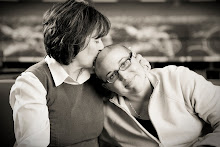Our trip to UCSF Medical Center could not have been better - which is relative, I know. Dr. Chang told us that Heather's tumor does not appear to have changed. In addition, the enhanced area around the tumor seems to be smaller than two months ago. With that said, there is always caution involved; however, we are VERY pleased and happy with that information.
Another good piece of information: Heather has only six months of chemo left. We were told by another doctor that some people remain on Temador for 4 - 5 years if their body can handle it. Somehow, the conversation lead us to believe that was the goal for Heather. Anyway, Dr. Chang told us that Heather is being treated aggressively, so we will hopefully be able to remain on Temador for one year if her body tolerates it. She has completed 6 of the 12 months. She will also continue to see Dr. Chang every two months. After she is off Temador for two months, she will again see Dr. Chang in two months. Then, if all goes well, Heather will start seeing Dr. Chang every three months.
Now, what does the future hold? Heather's type of brain cancer will grow again one day. However, as I wrote and told Casey William (a young MWHS graduate who now lives in LA and has just been diagnosed with giloblastoma multiforme) last night, that day does not have to be soon! We believe that new successful treatments are just around the corner. We believe Heather will beat this. We believe it is brain cancer's turn for a cure!
As I read Casey's blog, I became motivated once again to spread the word about brain cancer awareness. He too is asking that we spread the need for awareness. I feel LFAC has that mission covered, so we better get going again.
As always, thank you to those who faithfully read about Heather's Journey. I am going to start closing each entry with some brain cancer information:
Gliomas arise from the glial, or supportive, cells in the brain. There are different types of gliomas. Astrocytomas are gliomas arising from “star-shaped” cells called astrocytes. Oligodendrogliomas arise from “fried-egg shaped” cells called oligodendrocytes. Ependymomas arise from “corn-kernel shaped” cells called ependymal cells. When the specific tumor diagnosis is made by the pathologist, the tumor is also “graded.” This number grade is based on how normal – or abnormal – the tumor cells appear when examined under a microscope. Grade I tumor cells look slightly unusual when compared to normal brain tissue cells. On the other end of the scale, grade IV tumor cells appear to be very abnormal. In this four tier system, grade I tumors are called “benign,” grade II tumors are called “low-grade,” grade III (or anaplastic) and grade IV (or glioblastoma) tumors are called “high grade” tumors.
Subscribe to:
Post Comments (Atom)

No comments:
Post a Comment